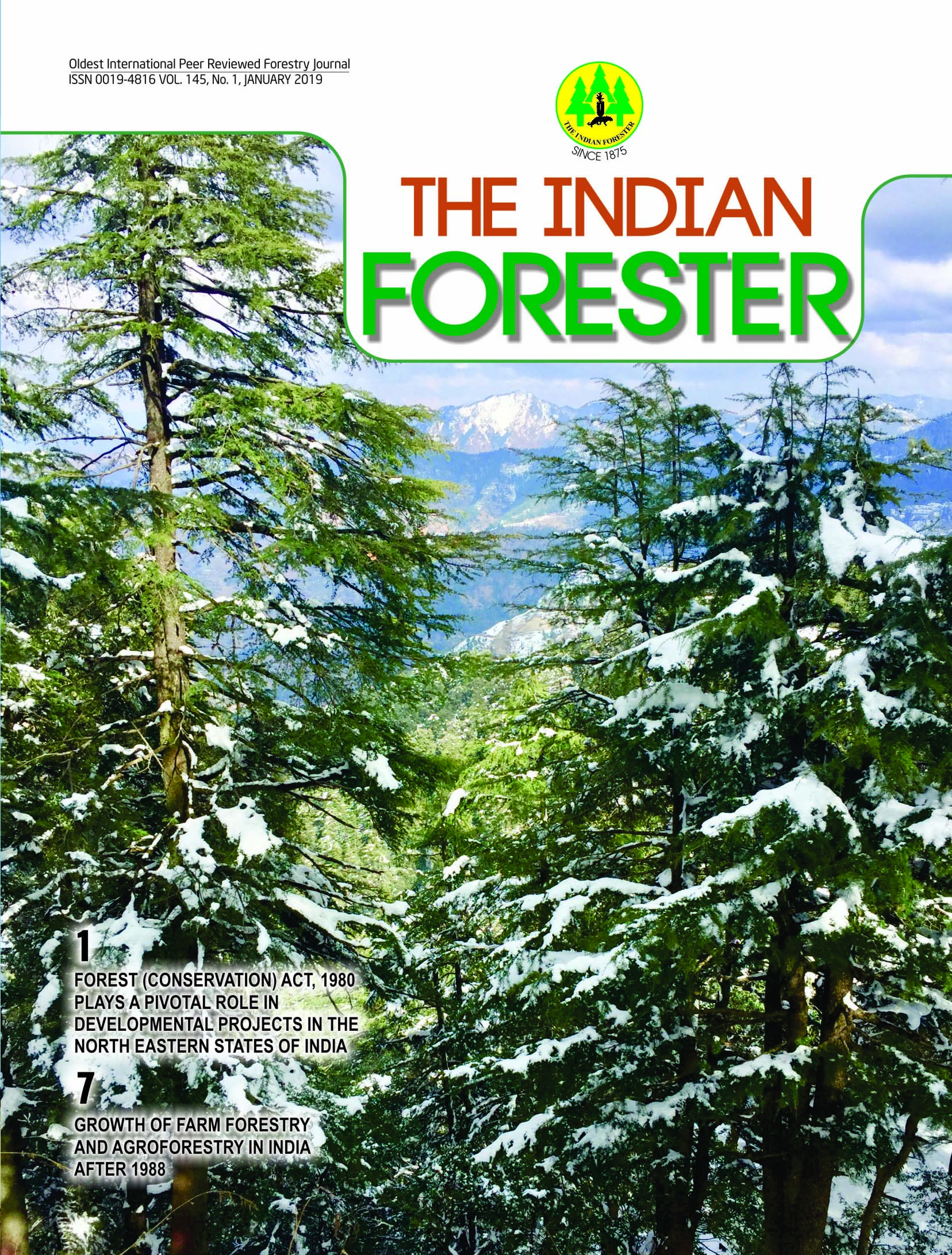Elevated CO2 Enhanced Growth and Physiological Process of Populus deltoides Bartr. ex Marsh
DOI:
https://doi.org/10.36808/if/2019/v145i1/126010Keywords:
Populus deltoides, Physiological response, Stem diameter, Open top chamber.Abstract
Accumulation of CO2 in the atmosphere considerably affect plants and trees of the terrestrial ecosystem. Under elevated CO2 , plants may alter growth and physiology for adaptation to survive. The aim of this study was to investigate the physiological and growth response of Populus deltoides grown under 600 μmol mol-1 of CO2 concentration in open top chamber (OTC). One-month-old homogenous plants were transferred in OTC for 180 days exposure of treatment and observed that as compared to control (∼400 μmol mol-1), stem diameter, photosynthetic rate, transpiration rate, stomatal conductance, intercellular CO2 concentration, intrinsic carboxylation efficiency and Ci/Ca were increased significantly. Intrinsic water use efficiency, instantaneous WUE, and Ci/gs were decreased significantly compared to control. The results indicated that P. deltoids plants can respond to elevated CO2 in terms of growth by the mechanism of photosynthesis and increased physiological processes. Plants maintain stronger stress tolerance mechanism via improvements in the synthesis of photosynthate and water retention capacity. Such behavior may facilitate plant adaptation to deal with climatic change and global warming. Tree productivity, vegetation, and ecosystem health may also be improved.
References
Ainsworth E.A. and Long S.P. (2005). What have we learned from 15 years of free-air CO enrichment (FACE)? A meta- 2 analytic review of the responses of photosynthesis, canopy. New Phytologist, 165: 351-371.
Arena C., Vitale L. and De Santo A.V. (2005). Photosynthetic response of Quercus ilex L. plants grown on compost and exposed to increasing photon flux densities and elevated CO . Photosynthetica, 43: 615-619. 2
Bazzaz F.A. (1990). The response of natural ecosystems to the rising global CO levels. Annual review of ecology and 2 systematics, 21: 167-196.
Bettarini I., Vaccari F.P. and Miglietta F. (1998). Elevated CO 2 concentrations and stomatal density: observations from 17 plant species growing in a CO spring in central Italy. Global 2 Change Biology, 4: 17-22.
Bhatnagar H.P. (1974). Vegetative propagation rooting practices with forest trees in India. New Zealand J. of Forestry Science, 4: 170-6.
Casson S. and Gray J.E. (2008). Influence of environmental factors on stomatal development. New Phytologist, 178: 9-23.
Ceulemans R. and Mousseau M. (1994). Effects of elevated atmospheric CO on woody plants. New Phytologist, 127: 2 425-446.IPCC (2013). Intergovernmental Panel on Climate Change.Climate Change 2013: The Physical Science Basis.http://www.ipcc.ch .
Liu J.X., Zhang D.Q., Zhou G.Y., Faivre-Vuillin B., Deng Q.and Wang C.L. (2008). CO enrichment increases nutrient 2 leaching from model forest ecosystems in subtropical China. Biogeosciences, 5: 1783-1795.
Mark S.J. (2000). Growth response of Quercus petraea, Fraxinus excelsior and Pinus sylvestris to elevated carbon dioxide, ozone and water supply. New Phytologist, 146: 437451.
Mattson W.J., Julkunen-Tiitto R. and Herms D.A. (2005). CO 2 enrichment and carbon partitioning to phenolics: Do plant responses accord better with the protein competition or the growth-differentiation balance models? Oikos, 111: 337-347.
Medlyn B.E., Barton C.V.M., Broadmeadow M.S.J., Ceulemans R., De Angelis P., Forstreuter M., Freeman M., Jackson S.B., Kellomaki S., Laitat E., Rey A., Roberntz P., Sigurdsson B.D., Strassemeyer J., Wang K., Curtis P.S. and Jarvis P.G. (2001). Stomatal conductance of forest species after long-term exposure to elevated CO concentration: a 2 synthesis. New Phytologist, 149: 247-264.
Noormets A., Sober A., Pell E.J., Dickson R.E., Podila G.K., Sober J., Isebrands J.G. and Karnosky D.F. (2001). Stomatal and non-stomatal limitation to photosynthesis in two trembling aspen (Populus tremuloides Michx.) clones exposed to elevated CO and/or O . Plant Cell and 2 3 Environment, 3: 327-36.
Norby R.J. and Zak D.R. (2011). Ecological lessons from free-air CO enrichment (FACE) experiments. Annual Review 2 of Ecology, Evolution, and Systematics, 42: 181-203.
Pandy D.K., Palni S. and Joshi S.C. (2003). Growth, reproduction, and photosynthesis of Ragweed parthenium (Parthenium hysterophorus). Weed Science. 51: 191-201.
Pearson M., Davies W.J. and Mansfield T.A. (1995).Asymetric responses of adaxial and abaxial stomata to elevated CO – Impacts on the control of gas-exchange by 2 leaves. Plant Cell and Environment, 18: 837-843.
Rae A.M., Tricker P.J., Bunn S.M. and Taylor G. (2007).Adaptation of tree growth to elevated CO quantitative trait 2 loci for biomass in Populus. New Phytologist, 175: 59-69.
Rapparini F., Baraldi R., Miglietta F. and Loreto F. (2004).Isoprenoid emission in trees of Quercus pubescens and Quercus ilex with lifetime exposure to naturally high CO 2 environment. Plant Cell and Environment, 27: 381-391.
Shabbir A., Dhileepan K., Khan N. and Adkins S.W. (2014).Weed-pathogen interactions and elevated CO growth 2 changes in favour of the biological control agent. Weed Research, 54: 217-222.
Singh H. (2015). All India Co-ordinated Projects on elevated CO . Project Completion Report submitted to Indian Council 2 of Forestry Research and Education, Dehradun, 156pp.
Wang X.W., Zhao M., Mao Z.J., Zhu S.Y., Zhang D.L., Zhao X.Z. (2008). Combination of elevated CO concentration and 2 elevated temperature and elevated temperature only promote photosynthesis of Quercus mongolica seedlings. Russian J.Plant Physiology, 55: 54-58.
Downloads
Downloads
Published
How to Cite
Issue
Section
License
Unless otherwise stated, copyright or similar rights in all materials presented on the site, including graphical images, are owned by Indian Forester.





